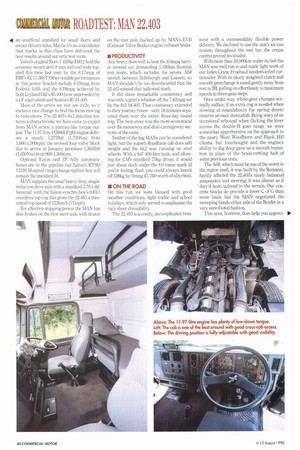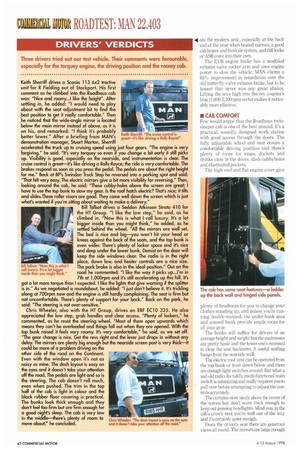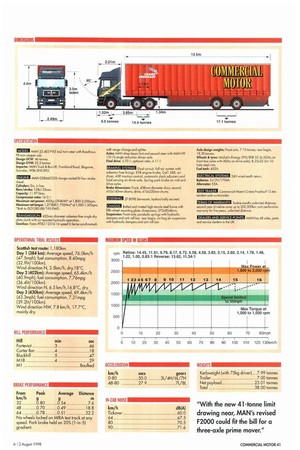ROADTEST: MAN 22.403
Page 40

Page 42

Page 44

Page 45

Page 43

If you've noticed an error in this article please click here to report it so we can fix it.
Britain's twin-steer tractor population has grown steadily in recent years, and with six-axle 41-tonners just around the corner they're set to become the vogue—VED rates permitting. MAN won't have its revised heavies ready until January, but for those who can't wait, the current F2000 6x2s could well be a good route to that extra payload...
Now that the Government has yet again side-stepped the 44-tonne issue, industry cynics are muttering that it wasn't so much a White Paper as a White Wash. The sting in the tail will no doubt become clear once the new Vehicle Excise Duty rates are announced in the next Budget.
Nonetheless, the trade in twin-steer tractors and 4x2 conversions looks set to increase, With the first 40 and 41-tonners due to hit the streets on 1 January 1999, operators seeking fleet replacements or additions will already be reviewing the 6x2 market.
We'll have to wait a while for MAN's revised 1;2000 heavies (CM 16-22 July), but having driven a 22.403 twin-steer around our Scottish test route we're convinced that it's a more-thancapable stand-in, whether at 38 or 41 tonnes.
Comparing its results with those of its 4x2 stablemate we tested last year (CM 6-12 March, 1997) reveals a remarkably consistent fuel consumption; unfortunately it's consistently average. MAN promises to do better with next January's models.
Frills apart, the reworked F2000's Roadhaus cab is virtually unchanged, but its 11.97-litre engine gets a four-valve head, 7.0' more torque across a lower rev band and the promise of better fuel economy and cleaner emissions into the bargain. Add Eaton Autoshift and ZF Servoshift boxes to the build list and things become much more interesting, despite the high on-cost.
A smooth transition is a major concern when any product is updated but we predict that the existing 22.403 FAIT will retain a strong appeal long after the arrival of its cleaner-breathing successor.
• PRODUCT PROFILE Despite all the razzmatazz attached to highpowered artics, 400hp seems to have become IP'.
an unofficial standard for small fleets and owner-drivers alike. Maybe it's no coincidence that trucks in this class have delivered the best results around our artic test route.
Volvo's original Eum-1 420hp FH12 held the economy record until it was well and truly toppled this time last year by the 847mpg of ERF's EC11 .38ST Other notable performances in this power bracket include 8.19mpg from Foden's 4405, and the 8.18mpg achieved by both Leyland Daf's 85.400 (now superseded by CF equivalent) and Scania's R124-400.
Most of the artics we test are 4x2s, so it makes a nice change to find the focus moving to twin-steers. The 22.403's 6x2 driveline features a characteristic we have come to expect from MAN artics: a plateau-like torque output. The 11.97-litre D2866LF(20) engine delivers a steady 1,2751bft (1,730Nm) from 1,000-1,500rpm; the revised four-valve block due to arrive in January promises 1,3641bft (1,850Nm) from 900-1,300rpm.
Optional Eaton and ZF fully automatic boxes are in the pipeline but Eaton's RTSO 12316 16-speed range-change splitter box will remain the standard fit.
MAN supplies the usual heavy-duty, singlereduction drive axle with a standard 3.70:1 differential: with the Eaton syrichro box's 0.83:1 overdrive top cog this gives the 22.403 a theoretical top speed of 1231cm/h (77mph).
For effective stopping power the MAN has disc brakes on the first steer axle with drums on the rear pair, backed up by MAN's EVB (Exhaust Valve Brake) engine exhaust brake.
• PRODUCTIVITY Any heavy does well to beat the 8.0mpg barrier around our demanding 1,180km Scottish test route, which includes the severe A68 stretch between Edinburgh and Consett, so MAN shouldn't be too downhearted that the 22.403 missed that hallowed mark, It did show remarkable consistency and was only a gnat's whisker off the 7.82mpg set by the 4x2 18.403. That consistency extended to their journey times-----only 18 minutes separated them over the entire three-day round trip. The Min-steer was the more economical over the motorway and dual-carriageway sections of the route.
Neither of the big MANs can he considered light, but the superb Roadhaus cab does add weight and the 6x2 was running on steel wheels. With a full 400-litre tank, and allowing for CM's standard 75kg driver, it would just about duck under the 8.0-tonne mark (if you're feeling flush you could always knock off 128kg by fitting ,f1,760 worth of ally rims).
• ON THE ROAD On this run we were blessed with good weather conditions, light traffic and school holidays, which only served to emphasise the rig's sheer driveability.
The 22.403 is a comfy, uncomplicated twin
steer with a commendably flexible power delivery. We declined to use the unit's air-con system throughout the test but the cruise control proved invaluable.
With more than 52,000km under its belt the MAN was well run in and made light work of our laden Crane Fruehauf tandem-axled curtainsider. With its nicely weighted clutch and smooth gearchange it eased gently away from rest in 3H, pulling on effortlessly to maximum speeds in three-gear steps.
Once under way whole-gear changes normally suffice; if an extra cog is needed when slowing at roundabouts the spring detent ensures an easy downshift. Being wary of an occasional rebound when flicking the lever across the double-H gate range we were somewhat apprehensive on the approach to the nasty West Woodburn and Black Hill climbs, but forethought and the engine's ability to dig deep gave us a smooth transition in place of the brain-rattling halt of some previous tests.
The A68, which must be one of the worst in the region (well, it was built by the Romans), hardly affected the 22.403's nicely balanced suspension and steering; it was almost as if they'd been tailored to the terrain. Our concrete blocks do provide a lower C of G than most loads but the MAN negotiated the sweeping bends either side of the Border in a very sure-footed fashion.
This area, however, does help you appreci
4 ate the modern artic, especially at the back end of the year when heated mirrors, a good cab heater and fresh air system, and duff-locks or ASR come into their own.
The EVB engine brake has a modified exhaust-valve rocker arm and uses engine power to slow the vehicle. MAN claims a 65% improvement in retardation over the old butterfly-valve exhaust brake, but to be honest that never was any great shakes. Lifting the revs high into the rev counter's blue (1,600-2,300rpm) sector makes it noticeably more effective.
III CAB COMFORT Few would argue that the Roadha us twinsleeper cab is one of the best around. It's a practical, soundly designed work station with good access through the doors. The fully adjustable wheel and seat ensure a comfortable driving position and there's plenty of room for maps. dockets and drinks cans in the doors, dash cubbyholes and elasticated pockets.
The high roof and flat engine cover give
plenty of headroom for you to change your clothes standing up, and unless you're running double-manned, the under-bunk area and unused hunk provide ample room for all your gear.
The bunks will suffice for drivers of an average height and weight but the mattresses are pretty basic and the lower one's recessed to clear the seat backrests. A useful suitbag hangs from the nearside wall.
The electric roof vent can be operated from the top hunk or from down below and there are enough light switches around. But what a sad old radio. Its tiddly multi-functional main switch is infuriating and really requires you to pull over before attempting to adjust the controls accurately.
The curtains stow nicely above the centre of the screen but don't seem thick enough to keep out passing headlights Mind you, in the cab's crow's nest you're well out of the way and it's certainly quiet enough.
From the driver's seat there are generous views all round. The mirrors are large enough to do an effective job, but not so large that they obstruct forward vision. Neat features include headlamps that hinge out to swap bulbs, an electric/hydraulic cab tilt (even if it is on the offside), hinged side panels and a ladder on the back wall for safe, easy access to the suzies.
The cab's had a couple of facelifts along the way and, despite the walnutty dash, the grey and black interior can look a bit drab. But this is no ageing agony aunt-more of a sensible trucker's time machine.
• SUMMARY
Like most of its F2000 stablemates, the 22.403 is a well-finished unit that is pleasant to drive on long-haul work with a cab that's comfortable enough for regular nights away.
Its £72,875 retail price is on the high side, as indeed is the £3,408 annual maintenance charge. However, MAN heavies tend to hold their value fairly well, and seem to be a good long-term investment. It will be interesting to see how much more fuel-efficient next year's improved engines are. For now the driveline under the sumptuous Roadhaus cabin may be a bit on the thirsty side, but it's powerful enough to cope with most types of haulage operation. Ride and handling char
acteristics are first class too. Cubbyholes and storage nets abound in the Roadhaus cab. Unladen weight can be critical on some operations and MAN'S big twin-steer withstanding, many hauliers will already be unit is a bit on the heavy side at just under looking for new 3+3 prime movers. MAN's 8.0 tonnes. But with the 41-tonne limit only a revised F2000 could well fit the bill. few months away and VED changes not I-1 by Bryan Jarvis Price as tested: £74,014 (ex-VAT). Includes £72,875 for basic chassis; £1,027 for cab roof and side deflectors; and £1,112 for air conditioning. Engine: 11.97 litres, 400hp (294kW).
GCW: 38 tonnes. Payload: 23.01 tonnes.
Speed: 69.8km/h (43.6mph). Fuel consumption: 7.80mpg (36.21it/100km).
SPECIFICATION
EMI MAN 22.403 FVLT 6x2 twin-steer with Roodhous FB twin-sIeeper cab.
Design GCW 46 tonnes. Design GVW: 22 5 tonnes Importer: MAN Truck & Bus UK, Fronkland Road, Blogrove, Swindon, Wilts 5N5 8YU.
mami MAN D2866LF(20) charge-cooled DI four-stroke
diesel.
Cylinders: Six, in line.
Bore/stroke: 128x155mrn.
Capacity: 11.97 litres.
Compression ratio: 16 0 1 Maximum net power: 400hp (294kW) at 1,800-2,000rpm.
Maximum net torque: 1,275168(1,730Nmr at 1,000-1,503, F
• Both to1501585 88/195 EWG
plate clutch with air-assisted hydraulic operation. TRANSMISSION 430mm-diameter asbestos-free single dry
Gearbox: Eaton RTSO 12316 16-speed S-Series synchromesh with range-change and soldier.
Axles: MAN drop-beam first and second steer with MAN HY I 3110 single-reduction driven axle.
Final drive: 3 70 1; optional ratio, 4.11:1 BRAKING SYSTEMS Dual-circuit, full-air system with asbestos-free linings. EVB engine broke, Cot 1 ABS, air dryer, ASR traction control, automatic slack adjusters and load sensing on drive axle_ Spring park brake on mid and drive axles.
Brake dimensions: Front, 438mm-diameter discs; second, 1 OxIA.Omm drums, drive, 410x220mm drums.
I114MS1 ZF 8098 Serrocom, hydraulically assisted.
CHASSIS Bolted and riveted high-tensile steel frame with
fifth-wheel mounting plate, dissensions, 270x80x8mm. Suspension: Front axle, parabolic springs with hydraulic
dampers and anti-roll bar, rear bogie, six-bag air suspension with hydraulic dampers and anti-roll bor.
Axle design weights: Front axle, 7.10 tonnes, rear bogie, 18.30 tonnes Wheels & tyres: Michelin Energy 295/80R 22.5s (XZAs on front two axles with XDAs on drive axle); 8.25x22.51n 10hole steel rims. Fuel tank: 40014.
ELECTRICAL SYSTEMS: 24V wired earth return. Batteries: 2c12V/170AB_ Alternator: 55A TEST TRAILER Commercial Motor's Crane Fruehauf 13.6m tandem-axle curtainsider.
TERMS OF WARRANTY: Twelve months unlimited distonce; second-year dnveline cover up to 200,000km, anti-perforation warranty for five years, unlimited distance.
DEALERS AND SERVICE POINTS MAN has 68 sales, parts and service dealers in the UK.
OPERATIONAL TRIAL RESULTS Scottish test route: 1,180km.
Day 1 (384 km): Average speed, 76.0km/h (47.5mph); fuel consumption, 8.60mpg (32.91it/100km).
Wrnd direction N, 3.5km/h, dry,1 8°C. Day 2 (402km): Average speed, 65.4km/h (40.9mph); fuel consumption, 7.76mpg (36.414/100km).
Wind direction N, 6.5 km/11,16.8°C, dry. Day 3 (430km): Average speed, 69.4km/h (43.3mph); fuel consumption, 7.21mpg (39.21it/100km).
Wind direction NW, 7.8 km/h, 17.7°C, manly dry.
HILL PERFORMANCE Hill min sec Forteviot 3 46 Carter Bar 4 18 Blackh ill 5 47 M18 4 29 MI Baulked BRAKE PERFORMANCE From Peak Average Distance km/h g 32 0.80 0.54 7.6 48 0.70 0.49 18.8 64 0.78 0.51 32.2
No wheels locked on MIRA test track at any
speed. Park brake held on 20% (1 -in-5) gradient. ACCELERATION km/h secs gears 0-80 50,0 3L/4H/6L/7H 48-80 27.9 7L/8L
IN-CAB NOISE
km/h dB(A) Tickover 60.0 64 67.5 80 70.5 90 71.6 WEIGHTS Kerbweight (with 75kg driver) .7.99 tonnes Trailer 7.00 tonnes Net payload 23.01 tonnes Total 38.00 tonnes
DRIVERS' VERDICTS
Three drivers tried out our test vehicle. Their comments were favourable, especially for the torquey engine, the driving position and the roomy cab.
Keith Sherriff drives a Scania 113 6x2 tractive unit for R Fielding out of Stockport. His first comment as he climbed into the Roadhaus cab was: "Nice and roomy. „I like the height". After settling in, he added: "I would need to play about with the seat adjustment bit to find the best position to get it really comfortable." Then he noticed that the wide-angle mirror is located below the main mirror instead of above, as it is on his, and remarked: "I think it's probably better lower." After a briefing from MAN's demonstration manager, Stuart Morton, Sherriff accelerated the truck up to cruising speed using just four gears. "The engine is very forgiving," he said. "It's very torquey so even if you change a bit early it still picks up. Visibility is good, especially on the nearside, and instrumentation is clear. The cruise control is great—it's like driving a Rolls-Royce; the ride is very comfortable. The brakes respond as soon as you press the pedal. The pedals are about the right height for me." Back at BP's Swindon Truck Stop he reversed into a parking spot and said: "That felt very easy. The electric mirrors give a bit more visibility for reversing." Then, looking around the cab, he said: "These cubby-holes above the screen are great; I have to use the top bunk to stow my gear. Is the roof hatch electric? That's nice; it tilts and slides.These roller visors are good. They come well down the screen which is just what's wanted if you're sitting about waiting to make a delivery." Bill Talbot drives a Seddon Atkinson Strato 410 for the HT Group. "I like the low step," he said, as he climbed in. "Now this is what I call luxury. It's a lot bigger inside than you might think," he added, as he settled behind the wheel. "All the mirrors are well set. The bed is nice and big—you won't hit your head or knees against the back of the seats, and the top bunk is even wider. There's plenty of locker space and it's nice and deep under the lower bunk. Demist on the door will keep the side windows clear. The radio is in the right place, down low, and heater controls are a nice size. The park brake is also in the ideal position." Out on the road he commented: "I like the way it picks up...I'm in 7th at 1,000rpm and it's still accelerating up this hill. It's got a lot more torque than I expected. I like the lights that give warning if the splitter is in." As we negotiated a roundabout, he added: "I just don't believe it. It's trickling along at 700rpm now and the engine is still hardly complaining. The seat is firm but not uncomfortable. There's plenty of support for your back." Back on the park, he said: "The steering is not over-sensitive."
Chris Wheeler, also with the HT Group, drives an ERF ECIO 325. He also appreciated the low step, grab handles and clear access. "Plenty of lockers," he commented, as he reset the steering wheel. "Most of them open upwards which means they can't be overloaded and things fall out when they are opened. With the top bunk raised it feels very roomy. It's very comfortable," he said, as we set off. "The gear change is nice. Get the revs right and the lever just drops in without any delay. The mirrors are plenty big enough but the nearside screen post is very thick—it
Keith Sherriff: "The cruise control is areat—it's Om driving a Rolls Royce!"
Bill Talbot "Now this is what : cell luxury. irs a lot bigger inside than you might Wink.'
could be more of a problem driving on the other side of the road on the Continent.
Even with the window open it's not as
noisy as mine. The dash layout is easy on the eyes and it doesn't take your attention off the road. The pedals are light and so is the steering. The cab doesn't roll much, even when pushed. The trim in the top half of the cab is light in colour and the black rubber floor covering is practical. The bunks look thick enough and they don't feel too firm but are firm enough for a good night's sleep. The cab is very low in the middle—there's plenty of room to move about," he concluded.












































































































